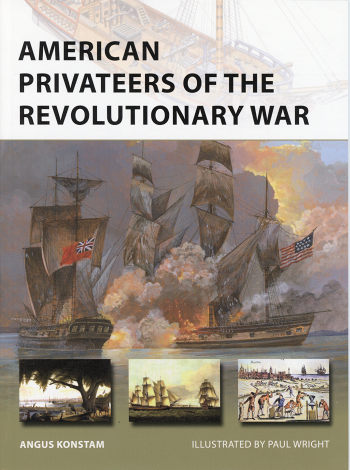 When
the American Revolution started. The Continentals did not have much in the way
of a navy. Indeed, it wasn't until a year later that one was formed. Yet, it was
important to break the British blockade of of American ports and to stem the
flow of troops and materials to the British.
When
the American Revolution started. The Continentals did not have much in the way
of a navy. Indeed, it wasn't until a year later that one was formed. Yet, it was
important to break the British blockade of of American ports and to stem the
flow of troops and materials to the British.
Realizing that building up a navy was going to take time and money, the
Continentals decided that the best way to take the fight on the seas to the
enemy was through the use of privateers. These were basically civilian ships
that were provided letters of marque to capture enemy ships. This was a common
practice at this time and was basically state sponsored piracy. Part of the deal
was that a fairly hefty portion of the sales of the ship and cargo would go to
the government while the rest was split up between the owners of the ship
and the crew. A successful trip would make enough to be very profitable. As
such, it was not difficult to get crews for these ships.
Initially, these letters of marque were given by the individual
colonies, but quickly this was centralized and offered by the Continental
Congress. In terms of ships, you would find a wide variety of sizes with most of
these ships being small converted cargo ships that were used in coastal trade.
It did not take much armament to convince an unarmed transport to surrender and
privateers carried sufficient additional crews to form prize crews and sail the
captured ship to a friendly port.
Few of these vessels were initially sufficient for open sea voyages so
early privateering took place fairly close to shore. Then investors decided to
build purpose built ships with fairly heavy armament. This was found to be
mandatory once cargo ships started arming themselves. Privateers were never
intended to come up against standard Royal Navy ships and were built more for
speed than weaponry in order to flee when outgunned. It is fortunate that the
majority of American ship designs were originally built for shallow water and
speed, traits which helped them not only overtake slower merchants, but also
evade British Navy vessels.
In this book, the author does a superb job of describing the differences
in ship building design and practice as well as taking the time to discuss the
different types of ships that were used in Privateering. Thanks to some great
period art work and drawings, we get to see what these ships were like. Add to
it the excellent art work of Paul Wright and you have another fascinating book
in this series. Well worth picking up.
January 2020
Copyright ModelingMadness.com. All rights reserved.
For more on the complete line of Osprey books,
visit www.ospreypublishing.com. If you would like your product reviewed fairly and
fairly quickly, please
contact
the editor or see other details in the
Note to
Contributors.
 When
the American Revolution started. The Continentals did not have much in the way
of a navy. Indeed, it wasn't until a year later that one was formed. Yet, it was
important to break the British blockade of of American ports and to stem the
flow of troops and materials to the British.
When
the American Revolution started. The Continentals did not have much in the way
of a navy. Indeed, it wasn't until a year later that one was formed. Yet, it was
important to break the British blockade of of American ports and to stem the
flow of troops and materials to the British.